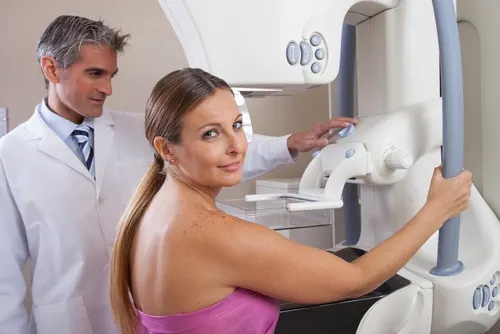7 Things to Expect During Your First Mammogram


Reviewed and approved by the doctor José Gerardo Rosciano Paganelli
If you’re between 35 and 40, you’re about to experience your first mammogram. We understand that you may feel nervous or anxious not knowing what to expect from this exam. However, it’s essential not to postpone or avoid it.
Breast cancer is the second most common type of cancer in the world and the most common among women. However, if it’s diagnosed early, there’s a good chance of recovery.
However, it should be noted that mammograms are not recommended for women under 40 years of age, except in high-risk cases. This is because the density of the breast tissue makes it more difficult for doctors to interpret the results.
If you’re about to have your first mammogram or simply want to be informed about it, take note of these tips!
1. You’ll feel an uncomfortable compression during a mammogram

If you feel pain, just remember that it’s for a few minutes and then it will go away.
You may be interested in: Types and Symptoms of Breast Cancer and Treatments
2. Avoid scheduling your first mammogram the days before your menstruation
Preferably, the mammogram should be performed during the second week of the menstrual cycle. During this period, there’s less density of breast glandular tissue, which helps the exam to be more detailed and with less discomfort.
In addition, during menstruation or in the weeks around it, the breasts are usually more sensitive due to hormonal alterations. This can increase discomfort and cause pain during the exam.
3. Notify your doctor if you have silicone implants
Silicone prostheses can interfere with the visualization of the breasts in the study. That’s why it’s extremely important to inform the technician who will perform the exam that you have implants.
The specialist will have to adjust the radiation doses so that the glands can be better visualized. You will also find that the position will need to be a little different, depending on the size of the implants.
4. Wear two separate pieces of clothing
Normally, you should remove the entire upper part of your clothing and wear a disposable gown that will be provided by the radiologist to proceed to your first mammogram. So, it’s best to avoid single pieces, such as dresses or clothes that are difficult to remove.
Ideally, you should wear a button-down shirt on the day of the exam, as it’s easy to remove and put back on. Keep in mind that wearing extra or difficult-to-remove clothing can also cause you to have to spend more time at the doctor.
If you’re short on time, you should wear something practical.
5. Avoid certain cosmetics in your armpits during a mammogram
The patient should not put any type of product in the breasts or armpits on the day of the exam. This is because they could produce images in the result that would confuse your doctor.
In this sense, you must pay special attention to the products that leave residues, such as creams, deodorants, and talcum powder.To avoid any problem, you can ask your doctor if your usual deodorant may cause any disorder in the image.
If you’re going to get your mammogram in the afternoon and you don’t want to spend the day without deodorant, you can go to the bathroom before the exam and wash your armpits. When you finish, reapply deodorant and you will be ready.
6. Position yourself comfortably during your first mammogram

Also, you should inform him/her of any limitations you may have, such as muscle stiffness or difficulties in raising your arms, among others. If, in any case, adopting the indicated position is impossible, you can also find other methods with the help of a specialist.
7. Only a specialist can interpret and explain the results

However, only your specialist can explain the results in more detail. It’s important that you don’t panic with any strange terms you see or worry too much.
Give your doctor time to examine the results and explain them to you.
We recommend reading: 3 Suggestions to Help You Face Breast Cancer
8. Keep calm during your first mammogram
Finally, during your first mammogram you may feel anxious, nervous, or confused. However, if you want to have the best quality of life, it’s a test that’s really important to have done.
It’s critical to prepare anytime in your 40s or even earlier if you have any risk factors. Analyze the things you should expect in this exam, leave your worries behind, and discuss the best time to perform the procedure with your doctor.
On the other hand, it’s very important to emphasize that if you feel the presence of any strange lump in your breasts, you must go to the doctor no matter how old you are.
All cited sources were thoroughly reviewed by our team to ensure their quality, reliability, currency, and validity. The bibliography of this article was considered reliable and of academic or scientific accuracy.
- CDC, Centros para el Control y la Prevención de Enfermedades. ¿Qué es una mamografía?. Última modificación de la página el 11/09/2018. cdc.gov/spanish/cancer/breast/basic_info/mammograms.htm
- Clínica Internacional. Consejos para la realización de una mamografía. (2016). clinicainternacional.com.pe/blog/consejos-realizacion-mamografia/
- Breastcarcer.org. Técnica de la mamografía y tipos de mamografía. Última modificación 17/09/2012. breastcancer.org/es/sintomas/analisis/tipos/mamografias/tipos
This text is provided for informational purposes only and does not replace consultation with a professional. If in doubt, consult your specialist.








